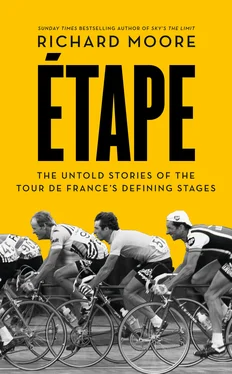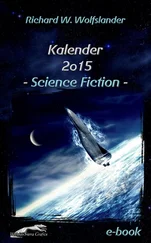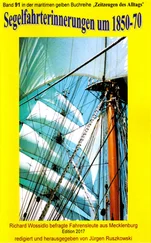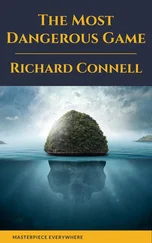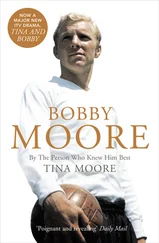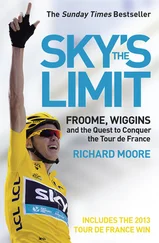Two weeks later, after the Pyrenees and the Alps, and stage nineteen presents Cavendish with a chance – a slim chance – of a fifth win. But he knows that the climb at the end, the 787-metre Col d’Escrinet, is a potentially insurmountable obstacle. The Cipressa and Poggio were pimples in comparison: the Escrinet was 14km long, averaging a gradient of 4.1 per cent, but, as Riis warned, much steeper at the bottom.
The stage gets off to a tough start: the 2.6km Côte de Culin after 6.5km, the first of two category-four ranked climbs. An obvious platform for an early break. Several riders attack, and a group of ten goes clear up the climb, with two more riders joining over the top. Five more try to get across, including perennial contender Cadel Evans, but when the dust settles, just 16km into the stage, the group is eleven-strong. Nine more bridge the gap over the following fifteen, rolling kilometres. The break includes some big hitters: Evans, David Millar, David Arroyo, Luis León Sánchez, Carlos Barredo. And Kim Kirchen.
Kim Kirchen’s presence is strange. Sitting in the peloton, Cavendish wonders why Kirchen, his team-mate, has joined the break. Cavendish had said in the morning, in front of everybody in the team meeting in the bus, that he fancied this stage, and thought he could win it. ‘But I need you guys,’ he told them. ‘I need you to help me just like you helped me over the Cipressa and Poggio.’
Most had written off Cavendish. In the Astana team bus, as a Eurosport on-board camera crew will reveal, that team’s directeur sportif, Johan Bruyneel, was apparently telling his riders: ‘Cavendish will be dropped on the Escrinet.’
Cavendish recalls: ‘We went over these two climbs early in the stage, cat. 4s. On the first one, the peloton split. There were Bouygues Telecom [the French team of Thomas Voeckler] on the front and it was all over the place. Little groups of three riders, all over the shop. There was another climb after that first one.’ La Côte de la forêt de Chambaran, 40km into the stage. ‘And it settled down on the descent, at least in the peloton. But the break had gone. And we had Kim Kirchen in it. I had said I wanted to go for it, but I don’t think Kim believed me. That’s why he went in the break. It meant we couldn’t chase.’
The gap, as they went over the second climb, was still only 40 seconds. The peloton had yet to decide whether to allow the break a ‘pass’ for the day. But as Cavendish says, the pressure went off on the descent; the gap went up to one minute thirty. Though the front group was big, six teams had failed to place any men in it. One of the teams that had missed out was Rabobank, who had Oscar Freire, their Spanish sprinter who was more than a sprinter. He was a better all-rounder than Cavendish; he specialised in sprints that followed tough little climbs. With the gap creeping towards three minutes, and 100km still to race, Rabobank went to the front and began chasing. This was a sign, too, that they didn’t expect Cavendish to survive that last climb.
‘When the break went and the bunch settled down, I thought we were going to be in for quite an easy day,’ Cavendish says. ‘Then we hit the crosswinds.’ Rabobank, a Dutch team, are past masters of riding in crosswinds; they anticipate them. ‘Freire fancied it,’ says Cavendish, ‘so he got his team to ride, and when they did, it was one line. Crosswinds, crosswinds. A couple of guys ended up being eliminated because of the crosswinds. It was brutal.’
For 60km, the road was undulating, twisty, through Montelier, Beaumont-lès-Valence, Beauvallon and into the Ardèche, the geographically diverse pocket in the south-east of France, famous for its forests and rivers, gorges and plateaux. The type of terrain that doesn’t lend itself to straight, flat roads: the kind of place that is beautiful to look at, punishing to ride in.
Cavendish did as little as possible as Rabobank, with help from Milram, working for their sprinter, Gerald Ciolek, led the chase. So Milram didn’t think Cavendish would survive the final climb, either.
Up front, the size of the break was proving unwieldy. It is difficult to get twenty riders to co-operate, or to continue to co-operate once the lead starts to fall; and with 65km to go, it dipped below two minutes. Then it began to break up; Millar, Popovych, Arrieta, Gutierrez and Duque go clear. They work well, building a 45-second lead; the bunch is just under two minutes behind them. But the peloton piles it on, racing towards an intermediate sprint in Saint-Julien-en-Saint-Alban with 37km remaining, at the foot of the Escrinet.
The break is swept up, but the five leaders hang on, just. Still Rabobank lead into the base of the climb. Then they are swamped by Cervélo, working for Thor Hushovd. The panic at the front is because so many are trying to be there for the steep early part of the climb: the all-round sprinters like Freire and Hushovd, who both fancy that they can hold on and profit when the inevitable happens and Cavendish is dropped; and the overall contenders, who cannot risk any surprise attacks, or being caught among the bodies further down the peloton. So Astana are near the front – Contador, Lance Armstrong; and Andy and Fränk Schleck are marking them; and Bradley Wiggins is there, guarding his fourth place overall.
The helicopter shots show the town of Aubenas – perched on a rocky outcrop, as the brochure described, surrounded by verdant slopes. The village looks cramped, old, the roofs of the buildings forming a terracotta patchwork. The cameras switch to an alternative angle on the race, at the rear of the peloton, the business end; it shows riders being spat out the back, including a few Rabobanks, their work done.
The bunch snakes up the climb. Fabian Cancellara is another big name dropped. Wiggins moves up the outside. Armstrong is lurking there, ominous. Off the back go his team-mate, Popovych, then Stuart O’Grady, then the King of the Mountains, Franco Pellizotti. Where’s Cavendish?
‘Bernie Eisel got me up to second in the bunch coming into the climb,’ says Cavendish. ‘I just sat there and counted; counted down the kilometres. It was Tony Martin at the front; he sat in front of me and rode me up. The first three and a half, four kilometres, I was riding as though that was the summit there. I remembered what Riis had told me: that if I could get past the first 4k I could hang on up the rest of the climb. And we came to this town, and I could hear on the radio there were guys getting dropped. I heard that [Heinrich] Haussler [another strong sprinter, second to Cavendish at Milan–San Remo] was dropped.
‘I just kept my rhythm. But I stayed in the top fifteen up there. I could see Rabobank go to the front, with [Denis] Menchov up there, and I remember just feeling comfortable. Then it kicked up again, the last couple of ks. And that did hurt.’
At this point, Laurent Lefèvre attacks, and he’s joined by the world champion, Alessandro Ballan. With the increase in pace behind them, Cavendish drops to fourteenth wheel, still with Martin in front, shepherding him. He has his hands on his brake hoods, perched on the nose of his saddle, and he is frowning. But additional support arrives in the shape of his Belgian team-mate, Maxime Monfort. He sits behind Martin; Cavendish sits behind both as riders pass him and he slides down the peloton. ‘I went halfway down the peloton. Luis León Sánchez attacked over the top, and he was getting behind the [TV and photographers’] motorbikes. The motorbikes that year, they were notorious for coming close to the peloton; they came really close to breaks and that.’ And riders could profit: tucking in behind them, getting shelter from the wind: even a brief moment would help.
Ballan and Lefèvre persevere – they have thirteen seconds’ advantage going over the top – but Cavendish is still there. ‘I recovered in about 300 metres of the descent, and went straight back to the front. I can descend better than the others, and the peloton was small.’
Читать дальше
